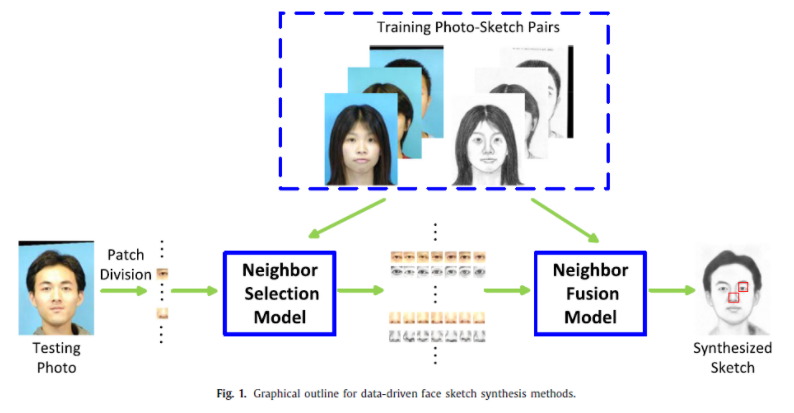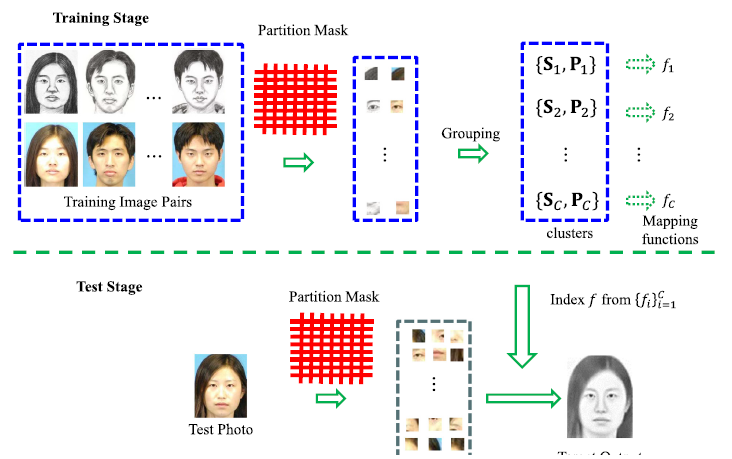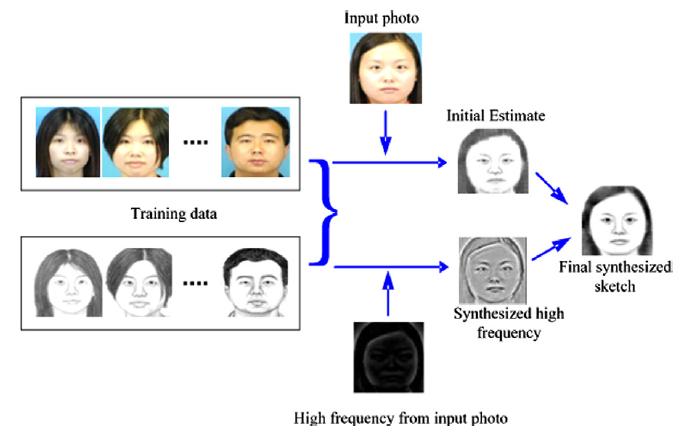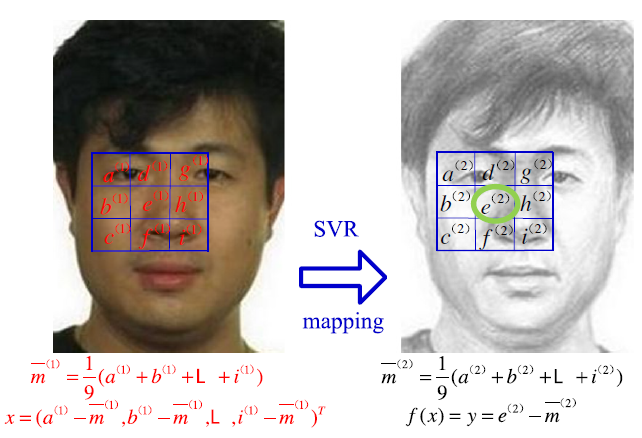文献阅读004【精读】
2017 Data-driven vs. model-driven Fast face sketch synthesis
相关文献:Heterogeneous image transformation
相关知识:KNN, SFS, SVR, high-frequency information
0.摘要
画像合成的旧方法——data-driven。
本论文提出画像合成的新方法——model-driven。
1.介绍
data-driven:如文献阅读001,002,都是基于该方法。
算法:
1.输入一张新图像 IP
2.从训练集T中的图像P拟合出新图像IP,记学得模型为:I=M(TP)
3.将训练集T中的画像S合成出伪画像IS,IS=M(TS)
4.输出一张合成画像 IS
一般,在第2步中,并不是把训练集中所有图像都利用起来,而是选取最合适的部分来拟合。有用KNN方法的,即从训练集中找出前K个与新图像最像的图像,这里的“像”,可以用几何距离来表示。
特点:计算复杂度与训练集的规模线性相关。
model-driven:
与data-driven不同,该方法不用遍历整个训练集的图像。
为什么不用?model-driven是直接学的一个模型,将 photo—>sketch。如下图:


2.Model-driven face sketch synthesis
如图Fig.2,如何求 fi ?用 ridge regression,目标函数:

sketch patch synthesis:

其他正则化技术:Laplacian regularization and p -Laplacian regularization
本论文用 python 的 scikit-learn package 来实现,λ取10^6。
在 Heterogeneous image transformation 一文中,说明了如果直接用上式来合成sketch,会出现过于光滑和模糊的现象,因为一些信息(hight-frequency information, detail information)会被过滤掉。
Zhang等作者在 Face sketch-photo synthesis based on support vector regression一文中提出用SVR的方法,他们用与合成 initial estimation(初步模型)不同的方法对high-frequency information进行合成,再补偿initial estimation缺失的信息,如下图。

其中,Heterogeneous image transformation 2012是在Face sketch-photo synthesis based on support vector regression 2011的基础上改进,同一个作者。
而本论文采用相同的方法,即对initial estimation, high-frequency information合成的方法都一样。
什么是 hight-frequency information?
在对图像分块的时候,之间会有部分重叠,但是使用KNN方法或者SFS方法加权后会丢失部分high-frequency information。
如何获得hight-frequency information?
给定一张手稿图,每个patch的high-frequency information等于每个像素点的灰度值减去该patch的平均值,差值大的就是high-frequency information。
输入:x,photo每个像素点减去一定范围内的平均值。
输出:y,sketch每个像素点减去一定范围内的平均值,该图片即high-frequency information。
训练得到的模型:f(x)
对于test photo,可以用训练得到的模型f(x)来得到其high-frequecncy information,最后将其fuse to a whole one image

【参考】
Heterogeneous image transformation
这篇文章分为两步:
- 用SFS进行初步的特征提取(改进了KNN的缺陷:K值固定使得有些并不邻近的点也被“强行”算作邻近点,这会使图像特征模糊)。
- 用SVR求出photo到sketch提取high-frequency information的模型,如下图。
Face sketch-photo synthesis based on support vector regression
就是介绍SVR的方法,在Heterogeneous image transformation均有介绍。
3.知识点收获
SVR,high-frequency information,SFS



